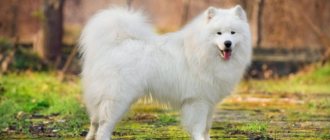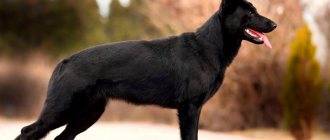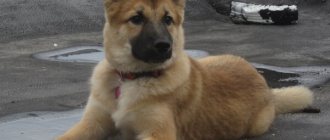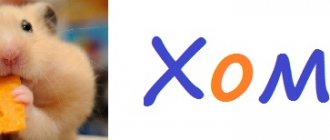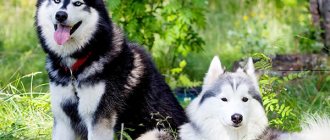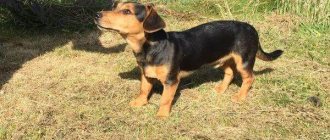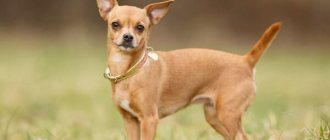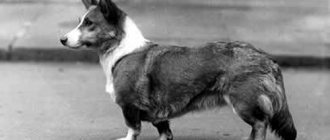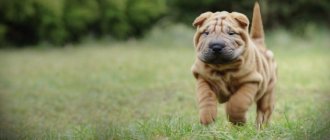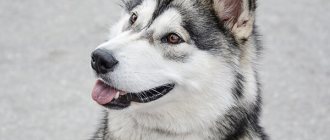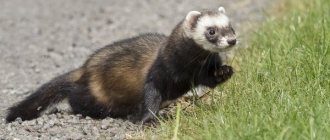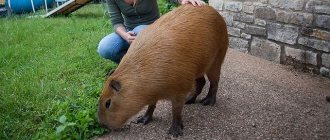One of the ancient breeds, bred in the steppes of China for more than 2000 years, was also common in Mongolia. Buddhist monks bred purebred dogs and kept pedigree records. There were never lions there, so the emperors wanted to have dogs like them, like lions. China is considered the homeland of the Chow Chow; their bas-relief images date back to 150 BC. e.
Reference! In Europe, a description of the chow chow first appeared in 1785 by G. White.
Chau means “shaggy lion” (from Chinese). The dog's temperament is also domineering.
What does a chow chow look like in the photo?
A correctly built dog with a rather massive, square body.
They have a majestic posture and a proud disposition . Despite the fact that Chow Chows are loyal to their owners, they are quite restrained in expressing their feelings.
They do not like noise and fuss and behave with the dignity of true aristocrats: their movements are calm and measured, and their gaze is full of grandeur.
The most characteristic breed characteristics of the Chow Chow include an unusually dense and thick coat, forming a thick collar around the animal’s neck, reminiscent of a lion’s mane, as well as a dark blue tongue .
Training
The difficulty in learning is not due to stupidity or poor memory, but because of the dog’s pride and stubbornness. She loves to rule, does not like pressure, so she does not want to obey, she loves to be a leader and control everything. When trained, the Chow is similar to a cat.
From a very young age, try to patiently train your pet for commands and for society.
Teach what is possible/not possible in a stern voice, and be sure to put a leash on the dog. You cannot hit or show aggression towards your pet. He will ignore the scream, hide and be able to take revenge.
You can’t pamper him either, lest he grow up to be an uncontrollable dog.
The main thing is to stick to the middle, persistently and positively educate, without shouting. Experts therefore do not advise beginners to own a Chow Chow.
Breed standard
The Chow Chow's head is quite large, but at the same time proportionate to the body.
The skull is wide and rather flat; the transition from the forehead to the muzzle, which is evenly wide along the entire length, is not sharp.
- The jaws are strong and strong, the bite is regular, scissor-shaped.
- The ears are erect, medium-sized, thick and dense, with slightly rounded ends.
- The eyes are oval, relatively small and dark.
- The neck is of medium length, voluminous and strong.
- The withers are pronounced, the back is level, straight and rather short. The chest is deep and moderately wide, with rounded ribs. The stomach is slightly tucked.
- The tail, lying tightly on the back and set quite high, is abundantly covered with grooming hair.
- The forelimbs are straight and strong.
- Hind limbs with well-developed and voluminous muscles on the thighs and minimal articulation angles. The hocks and metatarsals are directed vertically downward, due to which the dog moves with a kind of “stilted” gait.
Due to the fact that the ears are directed forward and slightly brought together, a gloomy and serious expression is created, typical of the Chow Chow..
Upbringing
A dog prone to aggression and dominance, like the Chow Chow, is especially in need of early training. It is important that the owner is able to convey that she occupies the last place in the hierarchical chain of the family. This is necessary so that the animal becomes disciplined.
Understand that there is nothing cruel about the standard prohibitions for pets. So, it is prohibited:
- Feed the dog from your table.
- Allow her to sleep in your bed.
- Ignore her barking for no reason.
- Encourage unnecessary displays of aggression.
- Set it on other animals.
Basic Chow Chow training lessons should be taught using a leash and collar. The inventory will help you feel each other better. After you firmly fix the collar on the dog’s neck, fasten the leash to it. The essence of training is to gain complete power over the Chow Chow. Move forward, keeping the dog a short distance away from you. Do not forget that the presenter is not he, but you.
Don't let the animal pull you forward. In this case, stop and pull the leash to the side. Such manipulation will cause minor discomfort in the area of its neck, after which the animal will stop.
Go for a walk with your pet every day. He should get used to the space that surrounds him. If he gets angry at the sight of a person or animal, again, pull the leash up.
Briefly about character and temperament
Chow-chows are calm and almost imperturbable dogs, which are characterized by such character traits as affection for the owner and distrust of strangers.
They are not naturally aggressive; they are quite friendly and phlegmatic animals. However, this does not prevent these dogs from being excellent guards.
IMPORTANT!
Chow Chows tend to become attached to only one owner.
Their early education is of paramount importance, since if by adolescence the Chow Chow does not choose the main owner in the family, then she may refuse to obey and recognize someone’s authority in the house.
These are quite independent and freedom-loving dogs who have their own outlook on life, sometimes not coinciding with the worldview of their owners..
Sometimes they can be incredibly stubborn and refuse to follow commands.
Chow Chows can be markedly distrustful of strangers and are not very friendly towards other people's pets.
They treat children kindly, but at the same time rather indifferently.
Character
Despite the stubbornness we wrote about above, they are great friends. They easily find a common language even with children, they are very affectionate and sociable.
The dog loves attention and care, so you shouldn’t have other pets, otherwise you won’t be able to escape jealousy.
Popular types and their descriptions
- Long-haired . The coat of these dogs is completely straight, long, thick and dense, forming a mane or a kind of collar on the neck and feathering on the hind legs. The guard hair is strong and rather coarse, while the undercoat, on the contrary, is soft and fluffy.
- Shorthair (smooth). The coat is straight, short and dense, as if stuffed. The texture and density resembles plush with long pile.
A feature of both long-haired and short-haired Chow Chows is the vertically growing coat that does not lie close to the body.
Care
For large Chow Chows, it is better to live in a country house with a spacious area. When protecting property and area, the pet reveals its instincts. Mandatory: physical activity and a large area to satisfy the dog’s curiosity.
To prevent your pets from getting bored, you should think through different routes for walks. He will like: the river, squares, forest belt and trips.
You need to walk for 2-3 hours with the dog: morning, afternoon and evening. Even running through a meadow outside the city, he will consider it his territory. This can cause quarrels with people and other dogs.
Keep his personal place clean; an orthopedic children's mattress is ideal.
Varieties by size
There are two size varieties of this breed:
- Standard . The height of males ranges from 48 to 56 cm and weighs 25-32 kg. Bitches are slightly smaller: their height at the withers is 46-51 cm, and their weight is from 20 to 27 kg.
- Mini. The height and weight of these dogs is less than that of standard dogs. On average, a male mini chow chow has a height of 37-40 cm, and a female - from 35 to 38. Minimum weight and height are not indicated, but a height of less than 30 cm for a mini chow chow is considered not very desirable.
The miniature variety of Chow Chow is not recognized by the standard: such dogs are not allowed for exhibitions or for breeding.
Main types of colors
Black
The most preferred is pure black without any extraneous shades. However, most Chow Chows of this color have lighter fur on the hind legs and tail.
Blue
It can be any gray-bluish shade: from light steel to dark lead.
Cinnamon
A brownish tint, from almost sandy to a diluted coffee-au-lait color, but always with a cool grayish-silver sheen.
Ginger
It can be either almost fawn or bright, rich red.
Cream
Cream Chow Chows are usually a pale golden or very light fawn color. But the palette of this color is much wider: it covers all shades from almost white to light caramel.
Grey
In fact, this is one of the variants of the blue color, in which sometimes there is a warmish sheen to the coat, which is why it does not look bluish, but rather gray or silver.
White
Pure white color, especially if it is associated with albinism, is considered a defect in the breed. But white in combination with yellowish or pale apricot darkening on the ears is considered a variant of the cream color and is not a plembrac.
The “panda” color popular on the Internet does not exist among chow chows: these are ordinary light cream dogs, whose fur has been artificially dyed black in places..
Advantages and disadvantages
Advantages of the breed:
- Attractive and original appearance;
- Good watchman;
- Gets along both in an apartment and outside in a booth or enclosure;
- Energetic and active;
- Clean.
Disadvantages of the breed:
- Stubborn;
- Difficult to train;
- Recognizes only the owners, treats strangers with suspicion;
- Indifferent to children, bad nanny;
- Tries to take the place of leader;
- Intemperate;
- They do not get along and compete with other pets.
Boys and girls: how are they different?
Male Chow Chows are larger and more massive than females . They are more muscular and compact in build.
Also, boys of this breed have a larger and more voluminous head, and a wider muzzle.
The coat of males is thicker and longer than that of females, and the mane and fringe are more pronounced.
What puppies look like (photos)
Below is a description of what Chow Chow puppies look like by month.
1 month
The puppies look well-fed, but not overfed.
They have a rather squat body, short thick paws, rather large heads with a slightly convex skull, short voluminous muzzles and small dense ears still pressed to the head.
The coat of babies is soft and even of long-haired puppies is short and plush . The eyes may retain a slight bluish tint, but the look is already serious and slightly frowning.
2 months
By this age, the coat of long-haired puppies noticeably lengthens, and the ears are slightly raised at the base.
The muzzles of two-month-old Chow Chows look a little longer than before, but the overall “plush” appearance is still retained.
3 months
Three-month-old puppies begin to develop hair in the form of a collar or mane. Their fur is now quite long and thick. The ears no longer sag, but stand up, although perhaps not quite vertically.
At the same time, puppies still look plump because they do not yet have the well-developed muscles characteristic of adult dogs.
4 months
By four months, the Chow Chow's legs and muzzle begin to lengthen.
At this age, they already have fairly long hair, forming a clearly visible mane and collar.
5 months
The little Chow Chow's coat lengthens even further and becomes thicker and denser.
She is no longer as plush as before, but by this age the puppy already has a fairly long mane and feathers on the tail and limbs.
The muzzle becomes longer and not as voluminous as before.
6 months
At six months, the body proportions of a growing chow chow become similar to adults. The legs lengthen so much that the body becomes almost square. Due to the onset of shedding, the fur looks so thick, and the mane and tail feathers become less fluffy.
7 months
Shedding continues, which is why the puppy's coat looks a little patchy and uneven in color.
However, by this age the mane again becomes well defined, and feathering again appears on the hind legs . Body proportions are already close to those of adult dogs.
8-9 months
The puppy is still shedding, and by this age the baby hair has almost completely come out, and the adult hair grows somewhat unevenly, which is why in some places, for example, on the back of the front paws, sparse fringes are formed that look like feathers.
By this age, many young Chow Chows have almost reached their maximum size, but continue to gain muscle mass and weight..
10 months
The molt is completely completed or is nearing its end and by this age the young Chow Chow finally acquires a truly long and thick mane and a fluffy tail.
The hair on the body also lengthens, although it does not yet reach its maximum length . The head and muzzle increase in volume and become more massive.
11-12 months
By this age, the Chow Chow has almost completely grown and the proportions of its body finally acquire the appearance typical for the breed. By this time, he has a long and lush mane, as well as feathering on the tail and hind limbs.
But the hair on the body is still short, it will grow later and reach its final length by about three years of age.
In the period from four to six to seven months, the puppy grows unevenly, but as if in parts, which is why the proportions and sizes of its body, paws and head are constantly changing.
Health
Diseases
The main diseases often found in Chow Chow dogs are:
- Hip dysplasia is a disease most often congenital, and when purchasing a puppy, you should inquire about the absence of this pathology in its ancestors.
- Eversion of the eyelid, entropion of the eyelid are congenital pathologies of the eyelids.
- Myopathy is convulsive muscle twitching that appears suddenly. Without timely treatment, the disease is fatal.
- Allergies , atopic dermatitis caused by food, pollen or unknown allergens.
Due to their low mobility, Chow Chows are prone to becoming overweight.
Vaccinations
Vaccinations are given to all babies who are two months old in order to have time to complete the full course before the teeth change.
Typically, complex vaccines of domestic or foreign production are used, and rabies vaccination is carried out no earlier than three months.
Important! Puppies prone to allergies are given suprastin in the dose recommended by the doctor a week before vaccination.
The next vaccination is given after changing teeth, at seven months, then at one year. Repeated vaccination is carried out annually.
Chow Chows are smart, but also very stubborn.
How to choose?
People who want to buy a Chow Chow should not rush to buy a dog. First, you need to decide on the gender and color of your future pet.
Bitches have a softer character and are less likely to be stubborn than males . But boys of this breed look more impressive, and therefore future owners who want to successfully exhibit their pets should think about purchasing a male dog.
A girl is better suited as a family dog, since the innate maternal instinct makes bitches more favorable not only to puppies, but also to small children.
You need to purchase a dog through a club or kennel.
However, when choosing a nursery on your own, you need to remember that some of them are not included in the RKF, and, therefore, a chow chow purchased there cannot be shown at all exhibitions, including international ones.
NOTE!
Buying a dog on the market and without documents of origin is fraught with the risk of purchasing not a chow chow at all, but a mixed breed or a mongrel puppy.
When choosing a future pet, you need to remember that it must be healthy, well-fed and moderately mobile. Excessive slowness, as well as excessive fussiness, can be signs of a not very good psyche.
The color of a small Chow Chow can differ noticeably from the color of an adult dog, so, first of all, you need to focus on what the parents of the chosen baby look like.
After all, the puppy will most likely inherit the color from one of them, and not from a more distant ancestor.
Nutrition
Regardless of the breed, each dog should receive a certain amount of carbohydrates and fats in its daily food intake. If a chow chow is overfed, this can lead to obesity and deterioration of the digestive system.
Before choosing any specific food for your chow chow , it is advisable to consult a veterinarian to ensure it is correct, taking into account the age and activity of the chow chow. As the dog gets older, the composition of the food will change, since you cannot feed a one-month-old puppy and an adult dog the same food.
The assortment on the market is very large, so everyone can choose the necessary food for each age of the dog, focusing on their wallet, since the food can be either budget or expensive professional.
But most veterinarians still advise sparing no expense and buying premium dry food. Due to their composition, they have a beneficial effect on the body and its condition.
If you decide to abandon such food and switch to natural food, then you need to monitor the amount of proteins and fats in it, since their excessive consumption is harmful to the chow chow. It would be better to sometimes include lettuce, parsley, and cereals in your diet.
White chow chow puppy, 3 months old
But if a certain type of food has been chosen for feeding, then you should not change it periodically. Combining dry food with natural food is highly discouraged.
